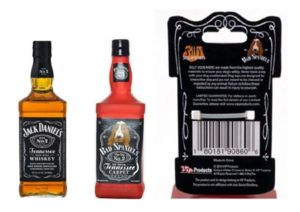 The United States Patent and Trademark Office (“USPTO”) recently announced a significant overhaul of its trademark filing fee structure. These changes, marked by substantial increases across various categories, will undoubtedly affect businesses seeking to protect their trademarks and brands. We highlight the key changes and impacts below. Continue reading
The United States Patent and Trademark Office (“USPTO”) recently announced a significant overhaul of its trademark filing fee structure. These changes, marked by substantial increases across various categories, will undoubtedly affect businesses seeking to protect their trademarks and brands. We highlight the key changes and impacts below. Continue reading
Tag Archives: trademark
Trademarks: Only Use in Commerce Establishes Ownership
 Trademarks can be a business’s most valuable assets. Apple’s mark is estimated to be worth more than $355 billion. The Amazon mark lags behind by a hair at $350 billion.
Trademarks can be a business’s most valuable assets. Apple’s mark is estimated to be worth more than $355 billion. The Amazon mark lags behind by a hair at $350 billion.
When the value of a company’s trademark can be so high, it makes good sense to carefully develop, grow and protect marks.
Trademarks can take many forms but first and foremost a mark must serve the purpose of identifying the source of goods in the minds of consumers. Letters, numbers, domain names, abbreviations, nicknames, words, slogans, color, alone or in combination with other colors, and designs can serve as marks.
The configuration of products or packaging, called “trade dress” also can serve as a mark if not functional. Generic terms (computertraining.com) can never serve as a trademark because they remain available for anyone to use. Marks that are merely descriptive of the goods (Ever Sharp) must acquire secondary meaning, being an association in the consumers’ minds between the goods and their source.
“First come, first served” is the basic rule of acquiring rights in a mark. Ownership of a distinctive mark goes to the first to use it in commerce; ownership of a descriptive mark belongs to the first mark that acquires secondary meaning through use. Continue reading
The Taco Tuesday Tussle
Some fast food trademarks make me hungry. Taco Bell’s recent fight with Taco John’s over Taco Tuesday® did so. But trademark battles between two fast food chains aside, I thought more interesting was how Taco Bell turned the dispute into entertaining advertising that promoted its brand more than its product. More on this shortly.
Is Taco Tuesday a proprietary trademark, a designator of a single source of a product? Is it a generic term, available for use by all sellers of tacos to describe in terms generally known to the public that tacos are eaten or a good deal on Tuesdays? The question to chew on is what has the public come to understand Taco Tuesday to represent? A designator of source, or is it merely a declaration used by many that Tuesday is a day to eat tacos? Even if it began life as a designator of source, it can become generic through use. Think shredded wheat, or aspirin. Continue reading
Chew on This: Parody of Famous Mark Not Protected by First Amendment or Excluded from Dilution Liability
On June 8, 2023, the Supreme Court of the United States issued a unanimous decision in the case of Jack Daniel’s Properties, Inc. v. VIP Products LLC, No. 22-148, 599 U.S. ___ (2023), ruling that when an alleged infringer uses a mark as a trademark to designate the source of its own goods, the Rogers test providing First Amendment protection for titles of artistic works does not apply to shield the challenged use from liability for trademark infringement, nor do the noncommercial use and fair use exclusions under the Lanham Act apply to foreclose dilution liability.
Jack Daniel’s makes and sells whiskey using the bottle design and label shown below, which are trademarks of Jack Daniel’s and are covered by several trademark registrations, including “Jack Daniel’s,” “Old No. 7,” the arched Jack Daniel’s logo, the stylized label with filigree (twirling white lines) and the distinctive square bottle design. VIP Products is a dog toy company that makes a line of chewable rubber toys called “Silly Squeakers,” many of which are designed to look like and parody popular beverage brands. Jack Daniel’s found no humor when VIP Products added the “Bad Spaniels” toy to its line (shown below), which is about the same size and shape as a bottle of Jack Daniel’s whiskey and uses the words “Bad Spaniels” in place of “Jack Daniel’s” in a similar font and arch, uses a similar black label and filigreed border, replaces “Old No. 7 Tennessee Sour Mash Whiskey” with “The Old No. 2 On Your Tennessee Carpet” and substitutes “43% poo by vol.” and “100% smelly” for “40% alc. by vol. (80 proof).” VIP’s Bad Spaniels product is packaged for sale with a hangtag (shown below) bearing two logos, one for Silly Squeakers and one for Bad Spaniels, and includes a disclaimer that the product is not affiliated with Jack Daniel Distillery.

Hermés: Protect the Trademark or the Art?
In the first trial involving non-fungible tokens, or NFTs, trademark rights and a First Amendment defense, a jury in New York City earlier this month found an artist had violated the trademark rights of Hermés, the iconic French fashion house.
At issue was the artist’s NFT depictions of Hermés’ Birkin bags and his use of the BIRKIN mark in connection with his art. NFTs are digital depictions of art that reside not on walls or shelves of collectors but in the cloud, accessible via the owner’s computer.
Do Analogous State Statute of Limitations Apply When the Lanham Act Provides None, Or Do Equitable Considerations, Such as Laches? How About Both?
The federal Lanham Act goes beyond trademark protection and establishes causes of action, as well, for unfair competition, false advertising, and false association. Section 43(a), however, does not contain a statute of limitations for claims that arise under the Lanham Act for any of these improper activities. That’s different from the Copyright and Patent Acts which each provide for limitations and apparently that’s the way Congress wants it.
The Anatomy of a Trademark Case
This article originally appeared in the Association of Corporate Counsel: Baltimore’s Focus magazine (3Q2022, p. 7-9). Written by Jim Astrachan, Kaitlin Corey, and Donna Thomas.
A trademark infringement suit awarding Variety Stores $95 million dollars against Walmart is instructive as to what the courts in the Fourth Circuit require to establish trademark infringement and willful trademark infringement. Variety Stores, Inc. v. Walmart Inc., 852 Fed. Appx. 711 (4th Cir. 2021) (unpublished).
While the large monetary award has been resolved behind the scenes through a confidential settlement following Walmart’s successful appeal relating to the trial court’s jury instructions concerning whether Walmart acted willfully, the magnitude of the award and the Court’s explanation of what is required to establish trademark infringement are worthy of discussion. This is especially important for those who are called upon to advise their client about whether a trademark is clear and available for use. The analysis for clearing a trademark for use is similar to the analysis that applies to determining whether a client will succeed if it sues on the grounds of trademark infringement.
A Brief Overview of the Trademark Registration Process
Before a business begins to use or files to register a trademark, it should research if other businesses are using the same mark for the same services, or if any have in the past. It should also do the same for any related, or similar marks for similar goods or services. This sort of search is designed to find federal trademark registrations, pending applications for federal registration, and common law (unregistered) trademarks that are in current use.
Such search should be conducted and reviewed by an experienced trademark attorney who can determine whether your proposed mark is, or may be considered, confusingly similar to a preexisting mark and can assess the risks associated with such finding. For example, if your proposed mark is confusingly similar to a preexisting mark, you face the risk of receiving a cease-and-desist letter or trademark infringement claim from the prior mark owner. You could also lose the investment and goodwill in your mark and spend considerable sums to re-brand your business if forced to cease usage.
Additionally, you will not be able to federally register your mark if it is confusingly similar to a mark covered by a prior federal registration or a prior-filed pending application. A trademark attorney can also advise whether your mark is distinctive (and thus capable of federal registration) or whether it is too descriptive to qualify for registration because the mark describes some feature, characteristic, function or purpose of the products or services to be provided under the mark.
